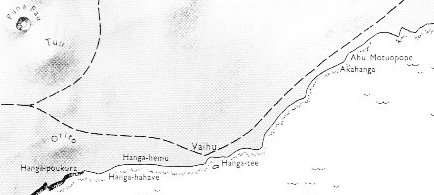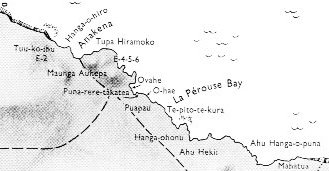|
TRANSLATIONS
The House of Cockroaches (Hare koka) was at Hanga-hahave.  A cockroach could alternatively be called 'potupotu':
The end, tip (potu) of the year occurs in Vaitu potu I once thought. But the name of the month was Vaitu poru. Or was it? I knew its name was said to be Vaitu poru but I changed it: '... I think potu is more probable than poru, a word which I do not understand ...' Vaitu nui means plenty of water and the opposite ought to be the next month, when water was scarce, ending the year with Vaitu potu. Now, when investigating it all again, I find that indeed Barthel 2 has Vaitu Potu. Unquestionably so. I was right, then. But from where did I get Vaitu poru? I have used that term in my glyph dictionary. Using my Index it is revealed that I got it from Heyerdahl 4: '... A way to obtain a better understanding of the half-years may be by determining the months (or double-months), what their names were and what kind of activities (events) they were connected with. I therefore have made a list of the names of the months.The list is based on information from Englert and the 'Atan manuscript' (according to Heyerdahl 4) ...' Possibly the origin of poru is a misprint. I now have to change everywhere in the glyph dictionary Vaitu poru into Vaitu potu. Circulating counterclockwise south of the equator the sun will reach midwinter, according to Easter Island sacred geography (and Barthel 2), at Vinapu. Hanga-hahave lies east of Vinapu, though, not at the end of sun's journey counterclockwise (if it did end at Vinapu):
I guess the myth teller must have had additional reasons for locating the action at Hanga-hahave - a station with very little (or nothing) left (potu) of the year. The main reason may have been that he thought of a clockwise cycle for the year, based not on the sun but on the moon. After all, 364 / 14 = 26. Vinapu lies due south from Ahu te Peu and Puna Pau will be passed by a bird flying from Ahu Te Peu to Vinapu. Tu'u ko ihu moved counterclockwise because he was a male chief. 5. In the 'scheme of lunar nights', Hanga Te Pau introduces the second half of the month in contrast to Hanga Ohiro, which introduces the first half. That means that Vinapu and Anakena were calendary opposites. Based on the encoded information gained from numbers 1 and 2, 'Maro' (for the Vinapu area) is contrasted with 'Anakena' (for the Anakena area) - or, to put it differently, the last month of the year is contrasted with the first month of the year. Hanga Ohiro is named Hanga Ohio in the map of Métraux (above).
Interestingly the name Tuu-ko-ihu is found close to Hanga-o-hiro. Was he originating there? Hanga Te Pau is not Hanga Pau Kura (east of Hanga Hahave). I cannot locate Hanga Te Pau on any of my maps, but reading Barthel 2 it is clear the bays are not the same: 49 Hanga Te Pau (lunar nights 15-17) "ko hanga te pau a ira he tini o te kainga a hanga te pau Hanga Te Pau, in the vicinity of Vinapu, is the landing site of the explorer canoe under the leadership of the first-born, Ira. Thus, the original place of arrival is reached again, but this time by taking a totally different route. One of the attributes of Hanga Te Pau is the 'middle (literally, 'zenith') of the land'. It may be that this was the starting point for the bisection of the island." Zenith (he tini) makes sense if we think in terms of the moon, but not if we think in terms of the sun. Hanga Te Pau is located immediately beyond full moon, pau means 'finished'. Barthel 2 has a span of three nights (15-17), but I am quite sure the 49th lunar station is the 17th night of the moon. 49 = 7 * 7. 46 Hare Hakangaegnae (13-15) "e tai a hare hakangaengae i te tahu hanga rikiriki The 'house that makes breathless' (or the 'house where one nods to each other') is located 'towards the sea'. I was told that the exact location is in the area east of Hanga Pau Kura. The 'very small bays' are supposed to be located west of Hanga Pau Kura. In a different combination, the words may indicate tending a fire (tahuhanga) or a small-sized fire (rikiriki). In this case, one would suspect a connection with the preceding motif of the earth-oven [cfr below at 45]. Tuu Ko Ihu and the origin of the wooden figures may provide an alternative explanation: the 'house where one nods to each other' suggests the reaction of the spirits who are eavesdropping and think they are unrecognized (TP:68), while the 'little ones' may be the carved sculptures." 45 Renga Havini (13-15) "e hue e renga havini e ka rangi atu koe kia nua kia motu roa ka vere mai taau taueve miritonu Renga Havini is located on the shore directly across from the islet Motu Roa. As for the calabash (hue), there is the possibility of a connection with Poie (ME:377) ['... who was burnt alive (tutu ora) in the course of a blood feud (ME:84) ...']. Again the additional text contains dommands: 'Call out to the mother (over there), to Motu Roa! Tear out the closure of your earth-oven made from seaweeds!' These commands must have been components of a story." |
.jpg)
